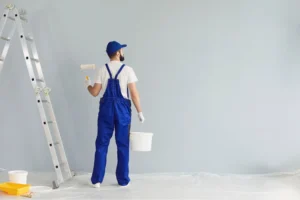You are walking back home after a busy day at work. Outside the house, you were staring at exterior walls because paint was peeling, fading and cracking from Vancouver’s harsh rainy and humid weather. And if you will not repaint your home for one more year, it will look horrible. But you are not alone in this. Just ask James.
He is also a homeowner like you in Vancouver who has ignored his house’s condition for so long. His vibrant blue house is now a dull shadow of itself. Paint is peeling in large patches, and mold is creeping everywhere. It is actually the right time to change but where to begin?
Preparing your home for exterior painting isn’t about picking colors only. It’s a whole task that requires time, attention and the right approach. So, if you are wondering how to get your home ready for that fresh coat of paint, like James, you can follow these simple steps and achieve lasting results.
Step 1: Access your Home’s Exterior Condition
James was standing in the garden, coffee in one hand. His heart feels broken every time he looks at dull and cracked walls, peeling paint and moldy patches on the sidings. “I should have done this every few years”, he thinks.
Before starting painting take some time to assess your home exterior’s condition. Everything has a different level of damage but must be sorted. Water damage, mold or wood rot can happen. Peeling or cracking paint, mildew and mold are common in our wet climate and need to be addressed before moving to the next steps. If you simply paint over these issues, it’s like masking the problem. A fresh coat of paint won’t make the mold or rot go away. Instead, the damage will continue.
Grab a ladder and assess all these problems closely. Check for spots that have issues, especially the shady and damp sides of your house. Take time and inspect all from siding to trim.
Step 2: Clean the Exterior
Ater inspecting the whole exterior, James knows that cleaning the surface is a must. He can’t jump into painting directly because those unchecked problems will not let new paint stick properly.
Cleaning is one of the important steps in prepping for exterior painting. New paint won’t last long because of dirt, mildew and old paint flakes. Paint won’t even last half of the time you expected it to last.
James used a pressure washer to clean that stubborn grime and debris. If you don’t have pressure wash that’s not an issue. You can also use garden hose and scrub brush. Clean all surfaces thoroughly, especially those shady parts we talked about earlier. You can use a mild detergent with water for ease and better results.
Step 3: Scrape and Sand
Once James was done cleaning, he saw flaky paint still clinging to the siding. Here the third step begins. He grabs the scrapper and gets to work.
If you are in a similar situation after cleaning, you need to do the same. By scrapping off loose peeling paint, you ensure that the new paint has a clean and smooth surface to adhere to. Leaving it will prevent new paint from bonding properly. That’s why scraping and sanding is an essential part of the process.
You can use a paint scrapper to remove any loose or flaky paint. Then use sandpaper to smooth out any uneven or rough surfaces for new paint. Wear protective gloves, goggles, and a dust mask while sanding or scraping. Especially if the paint applied previously was lead based, by this you can avoid inhaling dust or old paint chips.
Step 4: Make any necessary Repairs
While assessing the exterior, James figured out some section where wood was rotten because of water. “That needs to be fixed too.”, he takes a deep breath. Ven though it will be time taking but will result in bigger problems down the road.
If wood rot and cracks remain unchecked, the rot will spread and compromise the integrity of your sidings. It will lead to more damage over time. If the damage increased, costly repairs will be required to solve the issue.
James used caulk and wood filler for minor damage like small holes and cracks. For major ones, he replaces a few sections of sidings. This step can demand a little more time and money than the other, but it’s worth it to prevent further issues. So, if there is significant damage anywhere, don’t hesitate to replace wood.
Step 5: Protecting your surrounding areas
James knows that he must protect the areas that can be splattered with paint. He doesn’t want painters to get paint all over his driveway, windows or flowerbeds, so do you, I guess.
A painter’s job is all about details. If the painters don’t have to spend time protecting these areas, they can focus more on getting the job done right.
James grabs some painter’s tape and plastic sheeting to cover windows, doors, and any areas where he doesn’t want paint. He secured his garden beds with by pacing piece of cloths over them. He tried to cover all nearby surfaces that could be exposed to splatters. The more protection you set up now, the less cleanup will be required later.
Step 6: Scheduling Professionals for the right time
Finally, James is ready for the painting job, and so are you if you follow the steps. He scheduled an appointment for a time when the weather is dry, and the wind is minimal. Proper preparation not only saves you money by reducing the time the painters need on-site, but it also ensures that the new painting will last longer. The better you prep, the better the final result.
Ready to give your home the makeover it deserves?
Vancouver’s weather takes a heavy toll on your home’s exterior, so when it’s time to repaint, getting the prep work right is essential. By following these simple steps, like James, you can ensure that your home is ready for a professional paint job that will last through the city’s wet and windy seasons. Now that you’ve got your home prepped and primed for a fresh coat of paint, it’s time to let the professionals at Budget Painters handle the rest! With years of experience in Vancouver’s unique climate, our expert team ensures a durable, long-lasting finish that can stand up to the city’s wet, windy weather.

